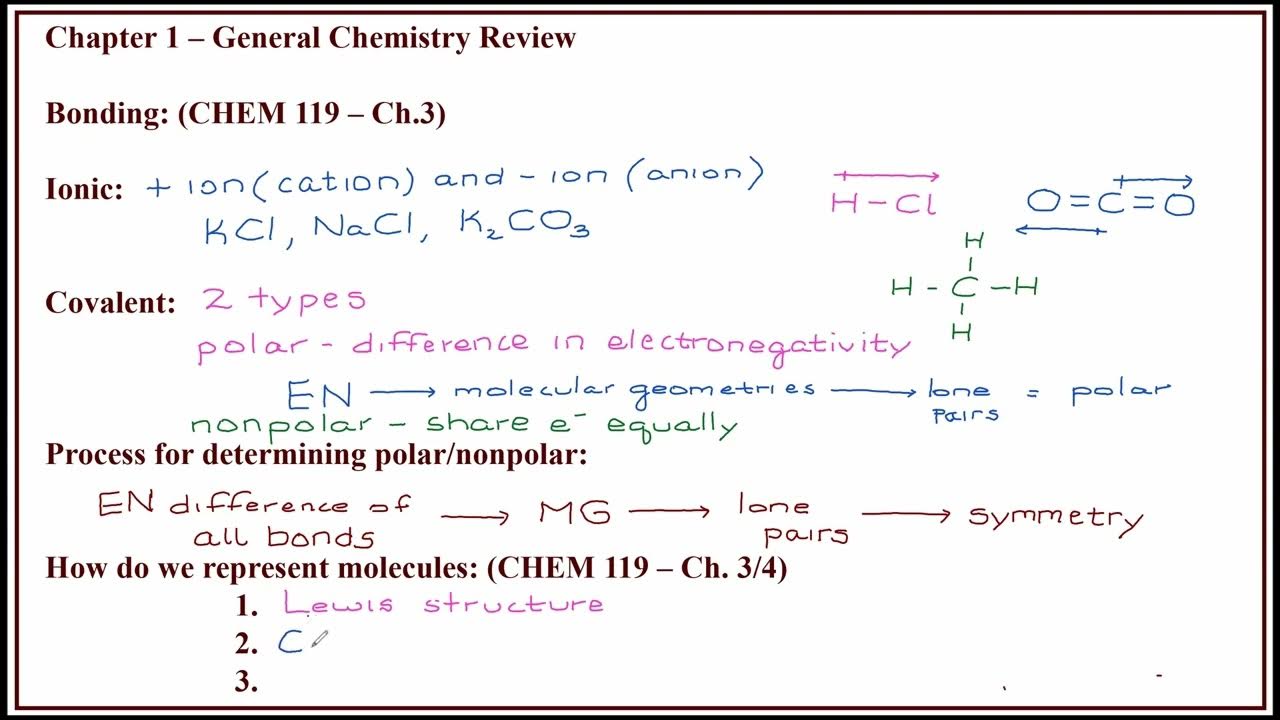Kimia Dasar 1- Muatan Formal ( senyawa Kovalen)
Summary
TLDRThis chemistry lecture focuses on the concept of formal charge, a theoretical charge assigned to atoms in covalent bonds to determine the correctness of Lewis structures. The formula to calculate formal charge is discussed, which involves valence electrons, bonding electrons, and non-bonding electrons. The lecture uses H2SO4 as an example to illustrate how formal charge can identify the most stable molecular structure, emphasizing that structures with zero formal charge are generally more stable. The 'Zero is the best' rule is introduced as a mnemonic for this preference, and the lecture concludes with an invitation for questions and practice exercises to reinforce understanding.
Takeaways
- 😀 Formal charge is a hypothetical charge assigned to an atom in a molecule to help determine the most likely structure of a compound.
- 🔍 The concept of formal charge is an extension of covalent bonding and is used to predict the correct Lewis structure of a molecule.
- 📐 Formal charge is calculated by the formula: Formal charge = Valence electrons - (1/2) * Bonding electrons - Non-bonding electrons.
- ⚖️ The purpose of calculating formal charge is to verify the correctness of the Lewis structure drawn for a compound.
- 🔎 Formal charge is particularly important for molecules with multiple possible Lewis structures, helping to identify the most stable one.
- 🌐 The stability of a molecule's structure is often associated with atoms having a formal charge of zero, as indicated by the mnemonic 'Zero is the best'.
- 🧪 Experimental data, such as bond lengths and bond orders, can be used to confirm the correctness of a Lewis structure, complementing the use of formal charge calculations.
- 📚 The example of H2SO4 is used to illustrate the calculation of formal charge and to compare different possible Lewis structures.
- 🔑 The script explains that the formal charge calculation can help distinguish between covalent and coordinate covalent bonds within a molecule.
- 📉 The script emphasizes that the formal charge should not be the sole criterion for determining the correct Lewis structure, especially when preparing for exams.
Q & A
What is the concept of formal charge discussed in the script?
-Formal charge refers to the charge that an atom appears to have in a molecule when it is calculated as if the electrons in a covalent bond are shared equally between the atoms involved.
How is the formal charge calculated?
-The formal charge of an atom is calculated using the formula: Formal Charge = Valence Electrons - (Non-bonding Electrons + 1/2 Bonding Electrons).
What is the significance of calculating formal charge in chemistry?
-Calculating formal charge is significant as it helps to verify the correctness of the Lewis structure drawn for a compound and to determine the most stable structure among possible resonance structures.
What is the role of the central atom in the Lewis structure of H2SO4 as discussed in the script?
-In the Lewis structure of H2SO4, the central atom is sulfur (S), which is surrounded by four oxygen atoms, with two hydrogen atoms at the ends of the molecule.
How does the script describe the difference between two possible Lewis structures for H2SO4?
-The script describes two Lewis structures for H2SO4, where the main difference lies in the distribution of electrons and the type of bonds (single, double, or coordinate covalent bonds) between sulfur and oxygen atoms.
What experimental data is used in the script to determine the correct structure of H2SO4?
-The script uses experimental data on bond lengths, specifically the bond length between sulfur and oxygen, to determine the correct structure of H2SO4, with the more stable structure having a bond length of 150 picometers.
What is the 'Zero is the best' rule mentioned in the script, and how does it relate to formal charge?
-The 'Zero is the best' rule is a mnemonic used to remember that structures with formal charges of zero are generally more stable. It suggests that atoms in a molecule with a formal charge of zero contribute to a more stable molecular structure.
How does the script explain the difference between covalent and coordinate covalent bonds in the context of H2SO4?
-The script explains that in the context of H2SO4, covalent bonds are shared pairs of electrons between sulfur and oxygen, while coordinate covalent bonds involve the donation of a lone pair of electrons from one atom to another, which lacks a complete octet.
What is the importance of octet rule adherence in determining the correct Lewis structure as per the script?
-Adhering to the octet rule is important in determining the correct Lewis structure because it ensures that each atom in the molecule has a full valence shell, which is a stable electronic configuration.
How does the script suggest verifying the correctness of a Lewis structure beyond just the octet rule?
-The script suggests using formal charge calculations and comparing them with experimental bond length data to verify the correctness of a Lewis structure beyond just the octet rule.
Outlines

This section is available to paid users only. Please upgrade to access this part.
Upgrade NowMindmap

This section is available to paid users only. Please upgrade to access this part.
Upgrade NowKeywords

This section is available to paid users only. Please upgrade to access this part.
Upgrade NowHighlights

This section is available to paid users only. Please upgrade to access this part.
Upgrade NowTranscripts

This section is available to paid users only. Please upgrade to access this part.
Upgrade NowBrowse More Related Video

CHEM 257 - Fall 2024 - Lecture 1 - Video 2

Formal charge | Molecular and ionic compound structure and properties | AP Chemistry | Khan Academy

General Chemistry Review for Organic Chemistry Part 3

Ikatan Kimia • Part 3: Ikatan Kovalen, Struktur Lewis, Aturan Oktet

Lewis Dot Structures

The Octet Rule: Help, Definition, and Exceptions
5.0 / 5 (0 votes)